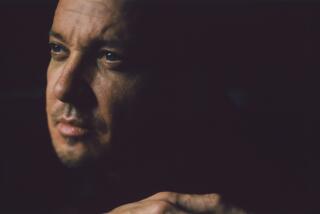On the mend, with a mission
- Share via
NEW YORK — He occasionally searches for a word and has limited vision in the right corners of his eyes. But aside from some red scars that pocket his face, there are few outward signs that 13 months ago part of Bob Woodruff’s skull was blown off by a roadside bomb in Iraq.
“I feel so lucky in so many ways,” the ABC correspondent said Monday, seated in an airy conference room in the network’s Manhattan headquarters. “I see what my family has gone through and I realize how difficult it has been.”
In “To Iraq and Back: Bob Woodruff Reports,” an hourlong documentary airing at 10 tonight on ABC, Woodruff tells the story of his recovery from the explosion that seriously wounded him and cameraman Doug Vogt. It’s his first time on the air since an improvised explosive device hit the Iraqi personnel carrier they were riding in north of Baghdad in January 2006, just weeks after he and colleague Elizabeth Vargas had begun their short-lived pairing as co-anchors of the evening news.
The bomb shattered Woodruff’s left shoulder and pelted his body with shrapnel, including a half-dollar-sized rock that pierced his neck, barely missing a key artery. In the immediate days after the explosion, he came close to death several times. The 45-year-old father of four was in a medically induced coma for 36 days.
When he woke up at the National Naval Medical Center in Bethesda, Md., Woodruff didn’t remember his brothers’ names -- or even the existence of his two youngest daughters. He couldn’t read or write or recall basic vocabulary. In one scene in the documentary, his three daughters huddle next to him on his bed, coaching him how to say “belt buckle.”
A year later, it’s difficult to believe he’s the same man whose skull was flattened on one side. (Doctors have since replaced the missing portion with a synthetic one.) On Monday, he easily rattled off statistics about the number of Americans who suffer from traumatic brain injuries and showed flashes of his impish humor, asking one reporter if he wanted to touch his fake skull.
Woodruff’s recovery has amazed doctors, some of whom doubted whether he would be able to speak again. But in the documentary, he does not dwell on his story. Much of the piece is devoted to the prevalence of traumatic brain injuries among U.S. troops and the limited rehabilitation care available for them when they return.
“It was very important to me that this story ... be about the other ones who went through this same kind of thing,” he said. “So many I’ve met have been in so much worst situations. They need a lot more help.”
For the piece, Woodruff obtained Department of Defense data indicating that at least 10% of the 1.5 million soldiers who have served in Iraq and Afghanistan could have an undiagnosed brain injury. Veterans Affairs has limited rehabilitation programs available for servicemen with such injuries.
When asked Monday if he believes the government is falling short in helping veterans, Woodruff offered a blunt assessment: “Yes.”
Tom Yellin, executive producer of the documentary, said he was struck by the reportorial approach Woodruff took. “Bob’s soul is of a journalist,” Yellin said. “His interest from the beginning was following the story with others and looking into the care that soldiers were getting, and he wasn’t dwelling on his own circumstances.”
One issue that producers immediately investigated: whether Woodruff, a high-profile television anchor, got better treatment from the military than the troops. “We checked pretty carefully and that’s not the case,” Yellin said. “The care he got from the moment the IED went off until he was released from Bethesda is standard operating procedure for the military.”
Woodruff has just a few memories from the day of the explosion. He remembers riding in the hatch of the Iraqi army vehicle right before the bomb went off, but he doesn’t recall the attack. “I do remember immediately at that moment that I saw my body floating below me and kind of a whiteness,” he said.
The force of the explosion threw him back into the tank. Woodruff’s producer, Vinnie Malhotra, saw a gaping wound in his neck and put his hand over it. The newsman’s only words: “Am I alive?” One of his first questions when he woke up was about Vogt’s condition. (The cameraman’s injuries were less severe and he has largely recuperated.)
“One of the other parts of guilt that I felt was what happened to others there with me,” Woodruff said. “Somewhere down at the bottom of me, I blame myself for being where we were.” He said he does not regret going to Iraq, his seventh trip there since 2002. “But this time around, that it caused so much trouble for my family, is hard,” he said. “You think through your head, ‘God, if I had done this a little differently, what if I had done a story in India instead of in Iraq, maybe I would be in a better position.’ But you know I could walk out of this building today and get hit by a truck. Who knows what’s going to happen?”
Woodruff and his wife, Lee, wrote a book, being released today, about his recuperation. He continues rehabilitation once a week and is working on other pieces about returning soldiers that will air in the coming weeks.
“Will I get back 100%? Probably unlikely,” he said, adding that he would be happy if he could “hit somewhere in the 90s.”
He wants to return to reporting overseas, although ABC News President David Westin has said he won’t send Woodruff back to Iraq because his head injury makes him more vulnerable in another attack. As for going back to the anchor desk, “It’s a possibility,” Woodruff said. “One thing just I can’t even believe I’m able to do right now is return to reporting,” he said. “That to me is plenty.”
*
More to Read
Sign up for Essential California
The most important California stories and recommendations in your inbox every morning.
You may occasionally receive promotional content from the Los Angeles Times.













